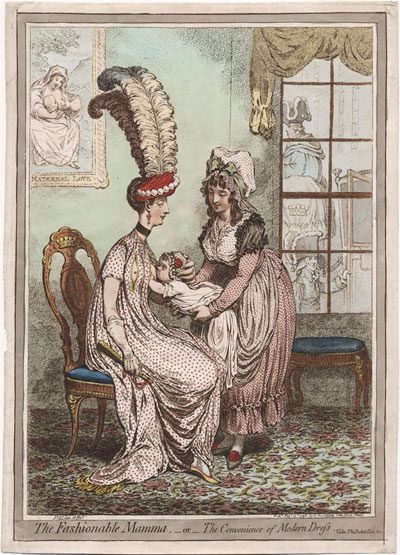The Fashionable Mamma, or The Convenience of Modern Dress
This is one of nearly a dozen prints published between 1794 and 1796 satirizing the latest women's fashions, in this case the clinging muslin dresses, huge plumes, and a renewed interest in breastfeeding.

[February 15/1796]
© Lewis Walpole Library, Yale University
For the first half of the 18th century, most ladies of fashion and means did not breast feed their children. They regarded it as an obstacle to their social life and figure—something better relegated to the lower classes. Instead, they hired women who had recently given birth to a child of their own, so-called "wet nurses" to perform that duty for them. Indeed, wet nursing had beecome a respected and sought-after occupation with better earning potential than most service and laboring jobs open to women. Mrs. Margaret Scott, the wet nurse for Queen Charlotte's first born, the Prince of Wales, was supposed to have received five hundred pounds for the first year and one to two afterwards. Though that, of course was an extreme, newspapers were routinely filled with ads placed by healthy young ladies, "with a good breast of milk" and with good characters and references, seeking positions as wet nurses.
After the publication of Jean-Jacques Rousseau's Emile, or On Education in 1763, attitudes towards breastfeeding began to change. As part of his belief in a "natural" man, before the corrupting influences of society, Rousseau believed that it was foundational for children to be suckled and nurtured "naturally" by their own mothers: "But let mothers deign to nurse their children, morals will reform themselves, nature's sentiments will be awakened in every breast," he wrote somewhat grandly.
The English cleric, Thomas Gisborne in his Enquiry into the Duties of the Female Sex (1797) agreed that women should suckle their own children and railed against a perceived selfishness of putting a child out to a wet nurse.
The first of the parental duties which nature points out to the mother is to be herself the nurse of her own offspring. In some instances, however, the parent is not endued with the powers of constitution requisite for the discharge of it. In others, the discharge of it would be attended with a risk to her own health greater than she ought to encounter when it can be avoided. In every such case the general obligation ceases. . . . But spontaneously to transfer to a stranger, as modern example dictates, the office of nurturing your child, when your health and strength are adequate to the undertaking; to transfer it that your indolence may not be disturbed, or that your passion for amusement may not be crippled in its exertions; is to evince a most shameful degree of selfishness and unnatural insensibility. (p. 364-5)
The "fashionable mamma" in Gillray's print seems to want to have it both ways. She is dressed to the height of the mode (literally) with soaring plumes, turban cap, form-fitting dress, and fan. Her carriage is waiting, ready to take her to the evening's entertainment. But she is fulfilling her obligations to suckle her child thanks to a young and buxom servant and the conveniently located pocket holes in her dress which allow her child easy access to her breasts without a rearrangement of her clothes.
In contrast, however, to the woman in the picture behind her labeled "Maternal Love," who actively offers her breast to the child held close in her arms, the fashionable mamma depicted in Gillray's print seems passively indifferent. Her gloved arm holds a fan not a child; her eyes are focused elsewhere, and the only contact between baby and mother is initiated by the child reaching for the breast. The kindly looking maid holding the baby seems much more engaged with the process, and there is a not so subtle suggestion that she would be a better nurse than the bored and flat-chested mamma who is only nursing because it has become fashionable.
A Note on Pocket Holes.
The strategically-placed pocket holes in the fashionable mamma's dress in this print were almost certainly a fiction created by Gillray for his own satiric purpposes. Because the fashionable muslin dresses of the 1790's clung to a woman's figure, bulky internal pockets and the holes that would permit access to them were eliminated. The internal pocket was replaced by external reticules or, as they were sometimes called "indispensibles" which were held in the hand or attached to a waist band.
Sources and Reading
- Commentary from the British Museum on The Fashionable Mamma, or The Convenience of Modern Dress.
- Draper Hill, Mr. Gillray The Caricaturist, 1965, p. 137 Plate 134
- Draper Hill, The Satirical Etchings of James Gillray, 1976, #39
- "History and culture of breastfeeding," Wikipedia
- "Wet Nurses and Nursing in the Eighteenth Century ," Geri Walton
- Thomas Wright and R.H. Evans, Historical and Descriptive Account of the Caricatures of James Gillray #415.
- Thomas Wright and Joseph Grego, The Works of James Gillray, the Caricaturist; With the History of His Life and Times, p. 209.
Comments & Corrections
NOTE: Comments and/or corrections are always appreciated. To make that easier, I have included a form below that you can use. I promise never to share any of the info provided without your express permission.